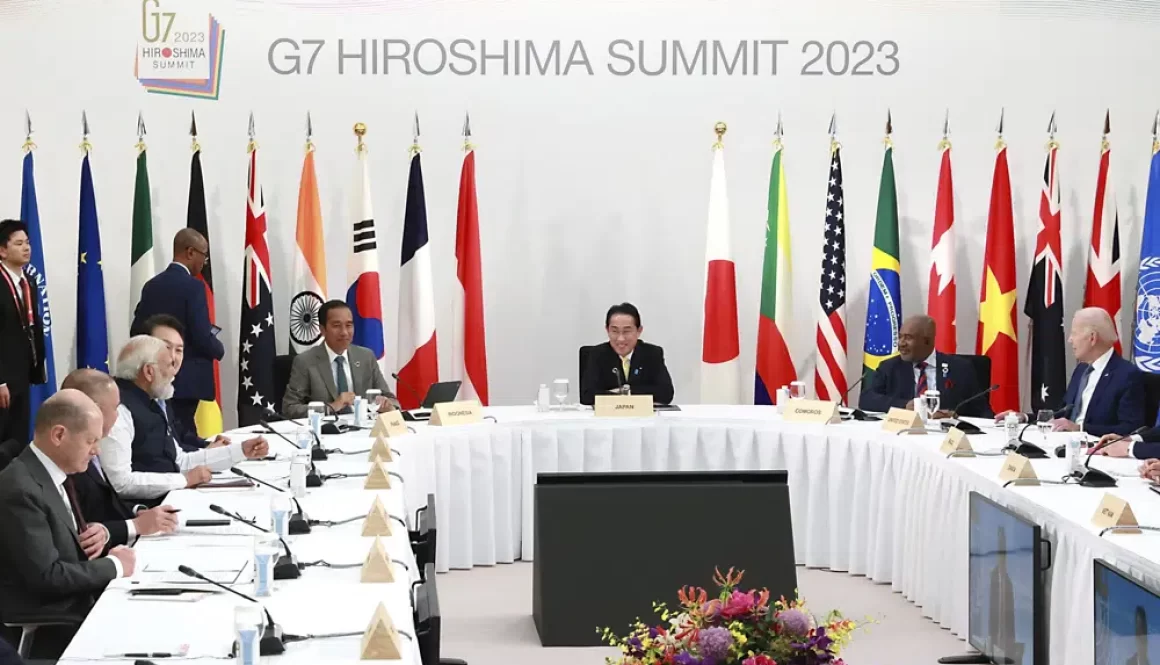The G7-China Rivalry: Power Dynamics and Influence Strategies in a Shifting World
The recent G7 Summit in Hiroshima, Japan, issued a final communique emphasising economic and military pressure on China. While the G7 claimed to seek stable and constructive relations with China, they strongly opposed militarization in the Asia-Pacific region.
The G7 Summit in Hiroshima, Japan, received notable attendance from partners, including Indonesia and Ukraine, adding to the discussions and deliberations.
The G7 so-called ‘constructive’ relations received backlash from China as it summoned Japan and criticized Britain over the ‘anti-China’ G7 Summit. China’s reaction signals its anger and protest over China-related issues. Not only on militarisation issues, such as in the Taiwan Strait, the G7 also pointed out the problems such as nuclear arms, economic coercion, and human rights abuses, which heightened the tension.
The Global Times stated that the US is trying so hard to weave an anti-China in the Western world, and it is a brutal interference in China’s internal and undisguised urge for confrontation. China’s close ally, Russia, was also against the summit, seen as an ‘incubator’ for anti-Russian and anti-Chinese.
The G7 and China ‘Rivalry’ on Influence
The G7 member states emphasized that their approach is not designed to harm China, but from the Chinese, it is threatening its interest globally. Japan’s ambassador to China, Hideo Tarumi, said that the issues discussed at the G7 Summit are justified and reflected the long concern with China’s behaviour. And they will continue the pressure if the Chinese refuse to change its policy and action.
Japan refers to China’s rhetoric around Taiwan and, as a whole, its economy and military action, including telling China to use its influence with Russia to ask Russia to withdraw its troop from Ukraine.
The continued rivalry between the G7 on China and Russia resulted in a ‘new Cold War.’ States compete, and to obtain and sustain their international influence, conditions must be more attentive to the power mechanism instead of just deploying their power resources. Power mechanism is states’ resources and activities to influence, which classify as a reward, punishment, expertise, attractiveness, and recognition, which then need to decide which approach and mechanism are most suitable for different targets.
Not only military power, but the state can also employ economic power. The G7 decided to influence its allies and partners to use ‘coercive’ tools through economic statecrafts, such as sanctions on Russia due to the war in Ukraine. Moreover, the G7 also decided to overview China’s ‘coercive’ economic approach while reducing economic dependence on China.
Power mechanism to influence other states
In international relations, a country’s power resources play a crucial role in its ability to exert influence. When a country possesses a wider range of power resources, it can have a stronger impact on other countries. Like Western countries and China, they have the power to influence; however, engaging in numerous influence activities doesn’t automatically lead to success.
Power mechanisms can be categorized into leverage (reward and punishment) and affective (expertise, attractiveness, and recognition). Leverage mechanisms change the costs or benefits of complying with the influencer’s preferences, while affective mechanisms alter the target’s perceptions of the influencer and the bilateral relationship.
Leverage mechanisms like reward and punishment are straightforward. Reward mechanisms involve providing positive benefits or protecting the target from negative consequences to increase compliance. Examples include military aid, trade agreements, and development assistance. Punishment mechanisms involve threatening or imposing negative sanctions to raise non-compliance costs. This can include military force, trade restrictions, and diplomatic censure. The leverage mechanism is used by the G7 member states and its alliance, including Australia, who support the effort taken at the G7 Summit to China. Protecting the member and partners of G7 from China’s ‘negative’ consequences are used through diplomatic censures such as warning and collective actions.
In the time the West focused on China, China broadened its engagement with Central Asia. China uses an affective mechanism, especially through its Belt and Road Initiative (BRI) program. China also held a ‘counter’ for the G7 Summit through the China-Central Asia Summit, focusing on regional trade and investment advancement. He highlighted the need for trust-building and expressed China’s willingness to provide support in areas such as law enforcement, security, and defence capability construction to enhance the development of Central Asian nations.
The rivalry highlights the importance of power mechanisms and influence strategies, with the G7 employing leverage mechanisms like economic coercion and punishment, while China focuses on affective mechanisms such as trust-building and economic support through initiatives like the Belt and Road Initiative.
